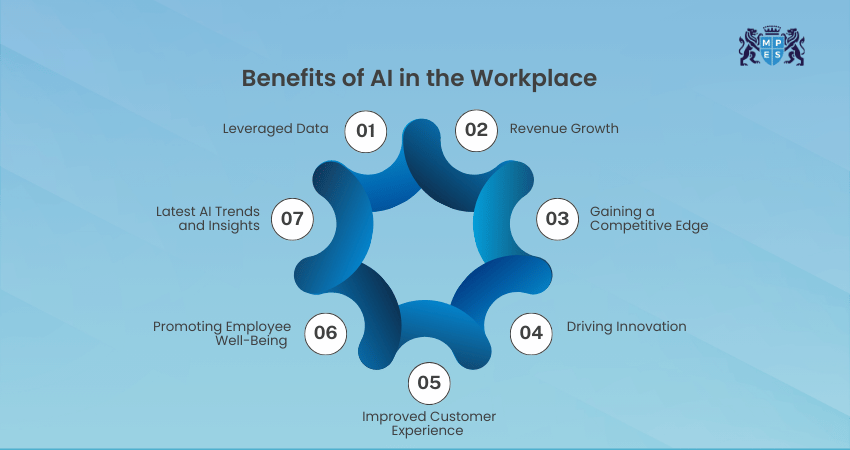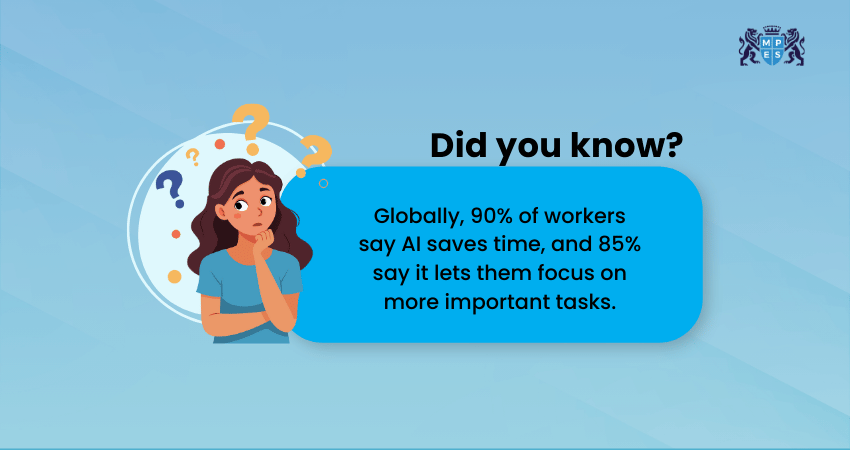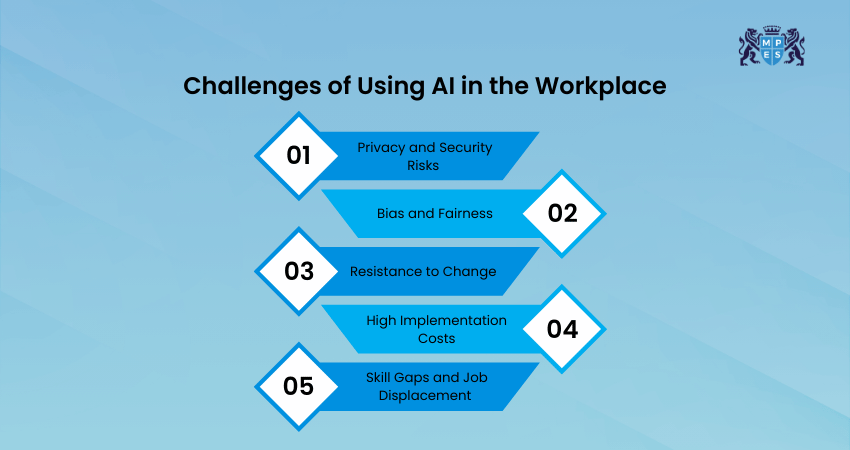Table Of Contents


Imagine having a tireless teammate who works around the clock, never takes a break, and always knows what to do next. This isn’t science fiction, it is the reality of AI in the Workplace. It’s helping you skip the repetitive stuff and focus on the work that really moves the needle.
From managing time off and automating service desk responses to powering HR support and improving data insights, AI in the Workplace is transforming how teams operate. It reduces errors, speeds up processes, and helps employees focus on meaningful information instead of repetitive work.
Table of Contents
AI in the Workplace
Benefits of Artificial Intelligence in the Workplace
Use Cases for AI in the Workplace
How to Implement AI in the Workplace?
Challenges of Using AI in the Workplace
Best Practices for Deploying AI in the Workplace
The Future of AI in Workplace
Conclusion
AI in the Workplace
Artificial Intelligence (AI) is modifying how businesses work. From increasing speed to helping with decision-making, AI is becoming an essential tool in Workplaces around the world. It can complete tasks faster than people, reduce human error, and even help make better choices based on data. Many companies now use AI to support daily work, improve services, and grow faster.
Whether in offices, factories, or customer service, AI is playing a big role in shaping the future of work. It helps both employees and employers by making jobs easier, safer, and more efficient.
Benefits of Artificial Intelligence in the Workplace
Artificial Intelligence enhances Workplace productivity by automating tasks, speeding up Data Analysis, and improving decisions. It also improves customer service, supports staff well-being, and reduces errors. Here are some key benefits of AI in the Workplace:

1. Leveraged Data
Companies gather large amounts of data every day. AI helps to make sense of this data quickly. It can analyse trends, find patterns, and give helpful insights that humans might miss. This helps businesses make good decisions and improve their services.
For example, AI tools can study customer behaviour and suggest what products they are likely to buy. This makes marketing and sales more effective with this information.
2. Revenue Growth
AI can help companies earn more money. By automating tasks, companies save time and reduce costs. This means employees can focus on more important work, while AI handles repetitive tasks.
Also, AI improves efficiency, which helps companies produce more in less time. This can lead to better profits and faster business growth.
Gain foundational AI knowledge to solve real-world problems. Join our Introduction to AI Course now!
3. Gaining a Competitive Edge
In a competitive market, AI gives companies an advantage. Businesses that use AI can work faster, reduce errors, and deliver better results. This helps them stay ahead of others who are still using traditional methods.
AI can also help companies quickly adapt to market changes and customer requirements, giving them a better chance of staying relevant.
4. Driving Innovation
AI encourages creativity and new ideas. It allows companies to explore new solutions and try different approaches. AI tools can even help create new products or improve existing ones.
By handling repetitive tasks, AI frees up employees' time to focus on innovation. This leads to better problem-solving and fresh thinking.
5. Improved Customer Experience
AI helps businesses provide better service to their customers. Chatbots can answer customer questions instantly, even at night. AI can also help personalise services by suggesting products based on a customer’s past purchases.
This makes customers feel understood and valued, which increases loyalty and satisfaction, one of the key advantages of using AI in the Workplace.
6. Promoting Employee Well-Being
AI can reduce the workload of employees by taking over routine and tiring tasks. This helps reduce stress and prevents burnout. Some AI systems also support mental health by offering reminders for breaks or providing access to wellness resources.
With fewer repetitive tasks, employees can spend more time on meaningful work, which improves job satisfaction.
7. Latest AI Trends and Insights
AI is developing quickly. Some of the latest trends include the use of AI in writing, image creation, and decision-making. Many companies are now using AI tools that can understand natural language and give helpful answers.
There has also been a rise in the use of AI to monitor Workplace efficiency and employee engagement. These tools help businesses learn what works best and where to improve.
Use Cases for AI in the Workplace
Artificial Intelligence offers many benefits, from faster operations to smarter decision-making and improved employee satisfaction. These advantages become even clearer when we look at real-world use cases for AI in the Workplace. These are the few use cases for AI in the Workplace:
1. AI for Smarter PTO lent
Managing paid time off can be a burden for HR teams, especially in large organisations. AI simplifies this by automating leave requests, tracking balances, and updating calendars in real time.
Example: A healthcare company started using an AI tool to handle leave requests, which made the process easier for both staff and HR.
2. Leveraging AI for the Service Desk
IT Departments are often overwhelmed with repetitive support tickets, which slow down service. AI solutions can handle common requests like password resets or access issues instantly and accurately.
Example: A tech company added a chatbot to its helpdesk system, which started handling many of the simple requests from employees.
3. AI Search for Workplace
Employees spend hours each week searching for files, documents, and internal resources. AI-powered Workplace search uses natural language to deliver fast and relevant results.
Example: A law firm added an AI search feature that helped staff find case documents and policies faster than before.
4. Generative AI for HR Support
HR teams face constant queries about policies, payroll, and employee benefits. Generative AI chatbots provide 24/7 answers and guide employees through common HR processes.
Example: A transport company added a virtual assistant to their HR system, so employees could ask questions without waiting for HR staff.
5. Streamlining IT Operations
Proactively managing IT infrastructure requires round-the-clock monitoring and quick response to incidents. AI systems detect unusual activity, predict system failures, and even resolve issues automatically.
Example: A retail company started using AI to keep an eye on their servers and spot issues early, helping avoid disruptions.
6. Supply Chain
Supply chains can struggle with inaccurate demand forecasts and delayed deliveries. AI optimises inventory tracking, predicts demand, and recommends efficient delivery routes.
Example: A supermarket chain used AI to improve how they stocked products, helping them avoid empty shelves or too much waste.
7. Sales and Marketing
Marketing teams often rely on guesswork to reach the right audience with the right message. AI analyses customer data, predicts preferences, and personalises content at scale.
Example: A beauty company used an AI tool to offer better product suggestions online, which helped customers choose what suited them best.
Learn to train algorithms using powerful ML frameworks with our Machine Learning Course – Register today!
How to Implement AI in the Workplace?
Understanding the benefits and use cases of AI is just the beginning. To make the most of it, organisations need a clear plan. These are the steps to follow when implementing AI effectively in the Workplace.

1. Define Clear Objectives
Before starting with AI, businesses need to decide what they want to achieve. It might be faster customer service, fewer mistakes, or smoother daily operations.
Example: A customer support team decided to use AI to reduce waiting times for incoming queries.
2. Assess Your Organisation’s Readiness
Not every business is ready to use AI right away. It is important to check if the tools, data, and employee mindset are in place. Leaders also need to make sure their teams are open to change.
Example: A manufacturing firm held team meetings to discuss upcoming AI tools and check staff readiness before moving forward.
3. Identify High-Impact Opportunities
It is a good idea to begin with areas that are slow, repetitive, or prone to errors. These tasks are easier to improve with AI.
Example: A retail company started by automating stock updates in their inventory system, which saved staff time every day.
4. Upskill Your Workforce
Staff don’t need to be tech experts, but they do need to understand how AI tools work and how to use them. Proper training helps people feel more confident and included.
Example: An HR department arranged workshops to teach staff how to use a new chatbot tool in their daily work.
5. Build a Robust Data Strategy
AI works best with clean, accurate, and secure data. Businesses need to make sure they’re collecting the right data and storing it safely.
Example: A healthcare provider reviewed their data systems to clean up old records before launching an AI-based scheduling tool.
6. Choose the Right AI Partner
Choosing a helpful and experienced AI provider is key. A good partner will understand your industry and offer advice throughout the process.
Example: A logistics company partnered with a provider who had worked with transport firms before, making the transition easier.
7. Launch a Pilot Project
Before applying AI across the whole business, start with a small test in one department. This gives teams a chance to learn and adjust.
Example: A finance team tested AI in their invoice tracking system first, before sharing it with other departments.
8. Scale and Integrate AI Systems
Once the test project works well, AI can be expanded to more areas. It should also fit in with the tools and systems people are already using.
Example: A media company added AI to their content search tool, then later linked it with their Project Management software.
9. Track and Measure Progress
It’s important to check if the AI tools are doing what they’re meant to do. Keep track of what’s working and what needs improving.
Example: A hotel group regularly reviewed how its AI booking assistant was helping customers and adjusted it based on feedback.
10. Collect Feedback and Improve Continuously
Ask your team how AI tools are working for them. Their feedback will help shape future improvements and show that their input matters.
Example: After launching a new AI tool, an office team held monthly feedback sessions to gather ideas and make updates.
Transform project outcomes with data-backed decisions with our Artificial Intelligence (AI) for Project Managers Course – Join now!
Challenges of Using AI in the Workplace
When we use AI in our Workplace, we may face some challenges. These are a few examples of challenges of using AI in the Workplace:

1. Privacy and Security Risks
AI systems often use sensitive data. If not managed correctly, this can lead to leaks or misuse. Companies must protect data and follow privacy rules. Strong security is key to building trust.
2. Bias and Fairness
AI can be biased if it learns from bad data. This can lead to unfair decisions, especially in hiring or promotions. It’s important to check AI for fairness and correct mistakes quickly. Fair AI supports equal treatment for all.
3. Resistance to Change
Some employees may be worried about using AI or losing their jobs. It's important to communicate openly and show how AI helps rather than replaces people. Support and training can ease the transition.
4. High Implementation Costs
AI systems can be expensive at the start. Small businesses may find it hard to afford. However, the long-term savings often make up for the cost. Careful planning helps control spending.
5. Skill Gaps and Job Displacement
Not all employees may have the skills to work with AI. Some jobs may change or disappear. Companies should offer training and help workers learn new skills. This keeps the team strong and ready for the future.
Best Practices for Deploying AI in the Workplace
Successfully implementing AI is only part of the journey. To ensure long-term success and value, here are the best practices for deploying AI in the Workplace.
1. Assess Current Capabilities
Know where your business stands. Check if the tools, data, and staff are ready for AI. This helps choose the right approach and avoid problems. Being prepared leads to success.
2. Develop a Data Strategy
Good data is the foundation of AI. Make sure it is complete, updated, and secure. A solid plan for data helps AI give better results. Data should be treated as a key business asset.
3. Start Small, Test, and Scale Strategically
Don’t rush. Begin with a small project, learn from it, and expand gradually. This helps lower risk and makes it easier to manage change. Small steps lead to bigger success.
4. Ensure the Business Readiness
Make sure leaders and teams are on board. Without support, AI projects may fail. Educate the team about benefits and provide ongoing help. A united effort brings better outcomes.
The Future of AI in Workplace
AI will continue to grow. In the future, it may take over more routine tasks and even help make complex decisions. It will also help create smarter offices, where systems talk to each other and adjust to employee needs.
AI in the Workplace will not replace humans, but it will change how we work. Employees will need to adapt, and businesses must support them through the transition. With the right balance, AI will make work better for everyone.
Conclusion
AI in the Workplace is transforming how businesses operate, improving efficiency, decision-making, and employee experiences. With the right approach, clear planning, and ongoing support, organisations can unlock their full potential. Embracing AI in Workplace settings today means building a smarter, more agile, and future-ready business for tomorrow.
Optimise system performance using AI-driven DevOps practices with our Artificial Intelligence (AI) for DevOps Course – Register today!
 Have Any Question?
Have Any Question?
 +44 7452 122728
+44 7452 122728






 Back
Back








 44 7452 122728
44 7452 122728





